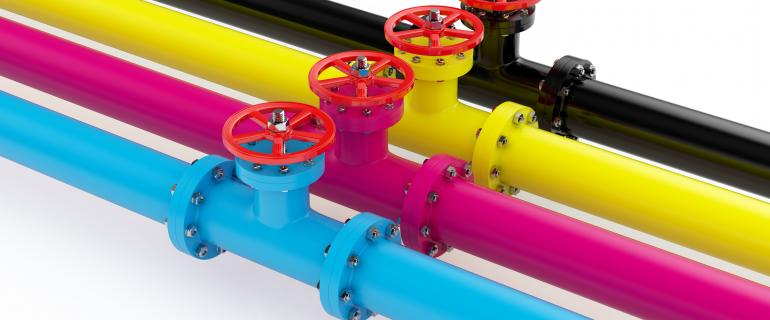What Makes an Industrial Inkjet Printer Different from a Typical Printer?
Millions of industrial packaging, labeling, coding, and marking operations choose to use continuous inkjet technology because of its numerous advantages over conventional drop-on-demand (DOD) inkjet printers. While DOD systems still have plenty of representation in industrial settings within use cases where they excel, continuous inkjet (CIJ) systems are specially suited to large scale printing and marking operations that utilize high-speed production, coding, and marking lines.
So, what makes your typical industrial continuous inkjet printer so different from a desktop printer in your office or a large DOD printer? Find out the answer as we examine three of the most important traits and benefits a CIJ printing system offers to industrial operations like yours.
The Difference is in the Discharge Method
As their respective names imply, the biggest difference between drop-on-demand and continuous inkjet printing systems is that ink flows constantly through CIJ systems, while being discharged intermittently in DOD systems. To manage inkflow and avoid wasting ink, CIJ systems also have a unique discharge element that applies electrostatic charges to ink droplets.
Drop-on-demand printers cycle between “on” and “off” ink flow modes rapidly – sometimes thousands of times in a second. There are two main discharge methods used for when printing is needed: thermal and piezoelectric.
Thermal inkjet printers use heat applied to the ink solution to forcibly eject it through the printhead and onto the paper or other substrate. A piezoelectric printhead uses a flexible material that changes shape when an electric charge is applied to it, creating pressure to mechanically eject the ink in the pattern desired. In either DOD system, ink is stored in reservoirs and must be kept from coagulating or chemically changing while not in use. Furthermore, printheads require constant cleaning in between on-demand printings.
Continuous inkjet systems also use piezoelectric equipment, but this is not the main discharge method. Instead, the piezoelectric device vibrates to separate ink into droplets. When a print job is performed, these droplets pass through a charging electrode, charging certain droplets. All the ink droplets then pass through another electrostatic field, which deflects the charged droplets and sends them through the print nozzle onto the substrate.
The majority of droplets are uncharged and simply collect into a reservoir to be recycled through the system and used again.
Continuous Inkjet Printers Reduce Clogging Risks While Allowing for Specialized Solvents
Because continuous inkjet systems do not have to worry about ink sitting unused, volatile solvents can be mixed in with the ink with minimal risk of evaporation. These solvents, which can include ketones and alcohols, give the ink a unique chemical makeup that can bind within the substrate and dry quickly.
The result is a permanent mark on a wide variety of both porous and non-porous substrates, with a quicker drying time and less ink consumption. However, solvent levels must be maintained. As a result, viscosity and current solvent volumes are measured and maintained as part of regular operation.
With Ultra-Fast Printing Using an Industrial Continuous Inkjet Printer, Mid-West Businesses Can Meet Throughput and Cost Demands
In addition to their abilities to recycle ink, reduce maintenance, and print using specialized solvents, CIJ printing systems also have the benefit of speed. The average CIJ unit can print anywhere from 450 to 700 feet per minute of text. The speed, low cost, and reduced maintenance factors combine to make continuous inkjet systems ideal for any high-speed marking or coding line.
Learn more about the benefits an industrial continuous inkjet printer can offer your specific operation, and what the best equipment might be to fit your unique needs, when you contact Raab today.


Comments
Add your comments